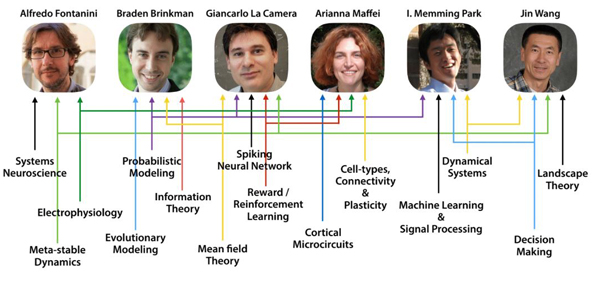The Department of Neurobiology and Behavior’s Center for Neural Circuit Dynamics recently received a $3.6 million grant from the National Institute of Health’s (NIH) Brain Research through Advancing Innovative Neurotechnologies (BRAIN) Initiative.
Center members include Department of Neurobiology and Behavior Professor and Chair, Alfredo Fontanini, MD, PhD, who is also Co-Chair of the Stony Brook University Neurosciences Institute; Associate Professor and Center Director, Arianna Maffei, PhD; Associate Professor, Giancarlo La Camera, PhD; Assistant Professors Braden Brinkman, PhD; and Memming Park, PhD, and Department of Chemistry Professor Jin Wang, PhD.
The Center’s project aims to use a combination of experimental and computational approaches (data analysis, machine learning, modeling and theory) to study how large ensembles of neurons organize to form coherent patterns of neural activity. This supports the long-term mission of the Center, which is to discover the fundamental principles underlying brain function by focusing on how the brain dynamically adapts over multiple timescales. The goal of the project is to understand how a brain circuit's wiring and its dynamics evolve during learning, readjusting with changes in environmental conditions and/or neurological state such as neurodegenerative disorders, age-related cognitive decline and drug addiction.
“The intersection between experimental and computational neuroscience is one of the most innovative areas and we are happy that Stony Brook’s strength in this field was recognized,” said Dr. Fontanini. “Of course, this grant is just a starting point for us to embark on a very exciting project and pursue even bigger opportunities.”
The BRAIN Initiative is aimed at revolutionizing our understanding of the human brain. By accelerating the development and application of innovative technologies, researchers will be able to produce a revolutionary new dynamic picture of the brain that, for the first time, shows how individual cells and complex neural circuits interact in both time and space. Long desired by researchers seeking new ways to treat, cure and even prevent brain disorders, this picture will fill major gaps in our current knowledge and provide unprecedented opportunities for exploring exactly how the brain enables the human body to record, process, utilize, store and retrieve vast quantities of information, all at the speed of thought.

